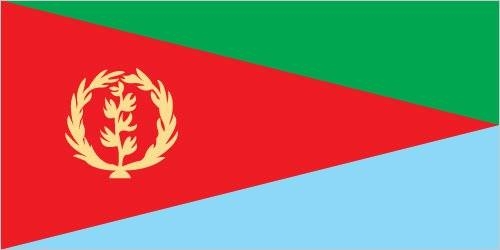194 Eritrea

Red isosceles triangle (based on the hoist side) dividing the flag into two right triangles. The upper triangle is green, the lower one is blue. A gold wreath encircling a gold olive branch is centered on the hoist side of the red triangle. Green stands for the country’s agriculture economy, red signifies the blood shed in the fight for freedom, and blue symbolizes the bounty of the sea. The wreath-olive branch symbol is similar to that on the first flag of Eritrea from 1952. The shape of the red triangle broadly mimics the shape of the country.
Flag courtesy of the CIA World Factbook

Map courtesy of the CIA World Factbook

Highlands between Asmara and Massawa
Government
According to Britannica, after liberation from Ethiopia in May 1991, Eritrea was ruled by a provisional government that essentially consisted of the central committee of the Eritrean People’s Liberation Front (EPLF). On May 19, 1993, shortly after a national referendum, this body proclaimed the Transitional Government of Eritrea. The intention was that this government would rule the country for four years, until the promulgation of a constitution and the election of a permanent government. The transitional government’s legislative body, called the National Assembly, consisted of the original 30-member central committee of the EPLF augmented by 60 new members.
The National Assembly elected independent Eritrea’s first president, Isaias Afwerki, in 1993. Following his election, Afwerki consolidated his control of the Eritrean government. As president, he was head of state and of government; he also presided over the legislature and the State Council, an executive body whose members were presidential appointees. In addition, he became commander in chief of the army and chair of the country’s sole political party, the EPLF, renamed the People’s Front for Democracy and Justice in 1994.
A constituent assembly ratified a new constitution in May 1997, but it was not implemented, and the anticipated parliamentary and presidential elections never took place. The 150-member Transitional National Assembly, an interim legislative body established in 1997, remained the de facto legislature into the 21st century, and President Afwerki maintained his powerful position. Citing national security concerns, he shut down the national press in 2001.
Civil / National Aviation Authority (CAA/NAA)
None found by the author.
However, should you, the reader, happen to stumble across something to the contrary, please email the author at FISHE5CA@erau.edu and you may be mentioned in the ACKNOWLEDGEMENTS section of this book by way of thanks for contributing to this free eBook!
Airspace
SkyVector – Google Maps – ADS-B Exchange
ICAO countries publish an Aeronautical Information Publication (AIP). This document is divided into three parts: General (GEN), En Route (ENR) and Aerodromes (AD). ENR 1.4 details the types of airspace classes they chose to adopt from classes A through G.
Drone Regulations
None found by the author.
However, should you, the reader, happen to stumble across something to the contrary, please email the author at FISHE5CA@erau.edu and you may be mentioned in the ACKNOWLEDGEMENTS section of this book by way of thanks for contributing to this free eBook!
Advanced Air Mobility (AAM) Regulations & Policies
None found by the author.
However, should you, the reader, happen to stumble across something to the contrary, please email the author at FISHE5CA@erau.edu and you may be mentioned in the ACKNOWLEDGEMENTS section of this book by way of thanks for contributing to this free eBook!
Advanced Air Mobility (AAM) News
None found by the author.
However, should you, the reader, happen to stumble across something to the contrary, please email the author at FISHE5CA@erau.edu and you may be mentioned in the ACKNOWLEDGEMENTS section of this book by way of thanks for contributing to this free eBook!
Short Essay Questions
Scenario-Based Question
You have been hired by a Drone Startup Company. Your boss has immediately assigned this job to you.
They need you to prepare a one-page memo detailing the legalities of using a drone to film Massawa, pictured above.
They need you to mention any national laws and local ordinances.
They specifically want to know what airspace (insert pictures) you will be operating in and whether or not you need an airspace authorization.
Does it matter whether or not you are a citizen of the country?
Lastly, there is a bonus for you if, as you scroll through this chapter, you find any typos or broken links!
Short Essay Questions
- What are the drone categories?
- How is registration addressed?
- How is remote ID addressed?
- What are the model aircraft rules?
- What are the commercial drone rules?
- Are there waivers or exemptions to the rules? If so, for what?
- Would you share a link to an interactive airspace map?
- How is BVLOS addressed?
- How can you fly drones at night?
- How can you fly drones over people?
- Where do you find drone NOTAMs?
- What are the rules for drone maintenance?
- What are the rules for an SMS program?
- What are some unique rules not mentioned above?
- What are the C-UAS rules?
- What are the AAM rules?

